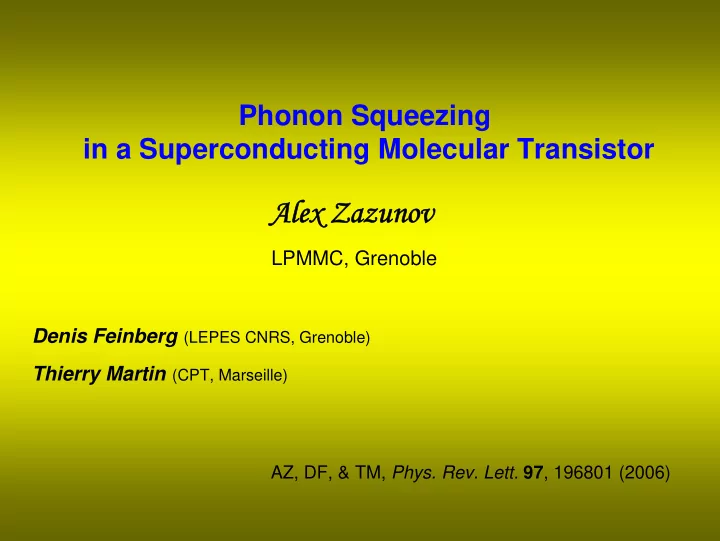

Phonon Squeezing in a Superconducting Molecular Transistor Alex Zazunov Alex Zazunov LPMMC, Grenoble Denis Feinberg (LEPES CNRS, Grenoble) Thierry Martin (CPT, Marseille) AZ, DF, & TM, Phys. Rev. Lett. 97 , 196801 (2006)
Contents • Introduction: - squeezed states in quantum mechanics - generation of squeezed states of nanomechanical resonators • Andreev bound states in superconducting molecular junctions • Effective Hamiltonian for Andreev levels • Phonon squeezing in the ‘toy-polaron’ model • Variational ansatz approach • Dissipation and detection of squeezed phonon states • Summary
Introduction: Squeezed states in QM Harmonic oscillator: Minimum-uncertainty states : Phase-coherent superposition of number (Fock) states displacement operator squeezing operator The variance of one quadrature component is reduced below the zero-point noise level
p p (vacuum state) q q p | α | q Squeezing effect results from the quantum nature of conjugated dynamical variables
Generation of squeezed states of nanomechanical resonators Hu & Nori, PRB (1996) • ‘Quantum phonon optics’ (in bulk materials) • Coherent quantum behavior of micron-scale mechanical systems with high quality factors (approaching Q~100000 below 50 mK): - entanglement and quantum superposition of spatially separated states [1] - minimum-uncertainty squeezing of the vibrational motion [2] [1] Armour, Blencowe, & Schwab, PRL (2002) [2] Blencowe & Wybourne, Physica B (2000); Rabl, Shnirman, & Zoller, PRB (2004); Zhou & Mizel, PRL (2006) • Applications: weak force detection,…, quantum computing (with continuous variables) Two phase qubits coupled through a piezoelectric resonator Cleland & Geller, PRL (2004)
Canonical squeezing Hamiltonian: • parametrically driven nonlinear potential of cantilever (starting from the GS of harmonic oscillator) Blencowe & Wybourne, Physica B (2000) • resonator weakly coupled to a charge qubit (2-level system) Zhou & Mizel, PRL (2006) Rabl, Shnirman, & Zoller, PRB (2004)
Superconducting Molecular Transistor • Josephson transport through a vibrating molecule • ‘Molecule’ = resonant electron level coupled to a local vibration • rf SQUID with a suspended CNT (vibration=bending mode) • Strong electron-phonon interaction ( g ~ Ω ) Sapmaz et al ., PRL (2006) Φ (magnetic flux) V g
Andreev bound states • no phonons: • degeneracy point: ‘slow’ single-electron tunneling, • ‘fast’ electron correlations in the Cooper pair Two-level Andreev bound-state system = phase-dependent hybridization of 0- and 2-electron (degenerate) states of the resonant level due to Cooper-pair tunneling: Δ −Δ
After tracing out the bulk degrees of freedom: Electron self-energy due to tunneling: Large Δ limit (no quasiparticle tunneling): Effective Hamiltonian : Effective current operator :
Spin – single-boson representation Pauli spin notation for the electron states: (Andreev level spectrum in the absence of phonons) The parity symmetry: Current operator:
Antiadiabatic limit: Rotation to the polaron basis: The ground state (to lowest order in Γ/Ω ): Entanglement in the charge-state basis (no squeezing) Spatially separated (α >1 ) phonon ‘cat’ states in the current-state basis: Josephson current is strongly suppressed for α>1 : Squeezing for Γ∼Ω (α<1):
D. Feinberg, S. Ciuchi, & F. de Pasquale, Toy-polaron model Int. J. Mod. Phys. (1990) λ = electron localization energy / delocalization energy Adiabatic approximation (λ <1, α>1): Anharmonic potential for phonon coordinate q: • single well for λ<1/2 Squeezing appears near the bifurcation point: • double well for λ>1/2 Bohr-Sommerfeld rule: the zero-point energy
Squeezing is a crossover phenomenon: It is maximal for intermediate coupling parameters of the polaron problem. 1 2 0.8 1.8 Δ p Δ x Δ p 0.6 1.6 0.4 1.4 0.2 1.2 0.5 1 1.5 2 2.5 3 0.5 1 1.5 2 2.5 3 λ λ Δ x Δ p remains close to one up to the bifurcation point (λ ~0.5 ), while Δ p<1 (squeezing)
Squeezing is tunable with the superconducting phase difference: its intensity depends on φ, in accordance with the effective polaronic interaction Γ/Ω = 0.5, 2, 4 g =0.9 Ω
Josephson current vs e-ph interaction ( φ=π/2) Γ/Ω = 0.5, 2, 4 λ The inflexion region corresponds to the polaron crossover regime where optimum squeezing is achieved.
• junction asymmetry leads to strong and nearly harmonic squeezing • weak φ− dependence γ = 0.5 and 0.75 Γ=4 Ω, g=1.5 Ω
Wigner distribution function of the squeezed phonon state g = 2 Ω, Γ = 5Ω Δ p = 0.69, Δ x Δ p = 1.15 Δ x Δ x Δ p Δ p
Variational ansatz approach • Strong electron-phonon interacting system (small-polaron problem) • The ground state of the system (junction + electrodes): δ, η - variational parameters The free energy: Renormalized tunneling width: The variational parameters are obtained by minimizing the free energy: • Good agreement with the exact large Δ calculations • Δ<< Γ: squeezing is still present provided that g> Ω
Dissipation and detection of squeezed phonon states Sources of dissipation: • decoherence of Andreev levels (external flux fluctuations) • coupling of the local vibration to other phonon modes NB Squeezing is the ground state property protected by the gap in the excitation spectrum Carbon nanotubes: large enough quality factors, Q ~ 1000 Resonant Raman Scattering : spectroscopy of the squeezed states ( photon is reemited with excitation of the phonon mode ) Projection of the ground state on the single-electron subspace: RR emmision lines (Stokes) at energies with the intensity
Summary • Josephson transport through a vibrating ‘molecule’ (suspended nanotube) • Josephson effect triggers coherent phonon fluctuations and generates non-classical phonon states (‘cat’ states, squeezed states) • squeezing occurs for a wide range of parameters and is maximal in the polaron crossover regime (Γ ∼ Ω ∼ g ) • squeezing is tunable with the phase difference (flux) • minimum-uncertainty state with ~40% squeezing can be obtained
Recommend
More recommend